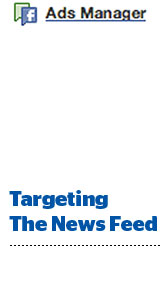 Facebook may be pouring on the revenue afterburners while reducing the precision of self-serve ad targeting in the news feed. Or, if you’re Facebook, the latest changes are all about making it simpler for the advertising long tail.
Facebook may be pouring on the revenue afterburners while reducing the precision of self-serve ad targeting in the news feed. Or, if you’re Facebook, the latest changes are all about making it simpler for the advertising long tail.
As many of you may know, AdExchanger reaches out through your Facebook news feed by posting links to our AdExchanger website content on our Facebook fan page, which you have (hopefully) “liked.” Because this will reach only a limited audience of likers, we often “amplify” that message through Facebook. This means we buy paid media through Facebook’s self-service ad tool and the little promotion button you see on the Facebook post itself. This delivers the post into your news feed.
There used to be two ways to segment Facebook news feed targeting in self-serve: (1) target your fan page’s likers, or (2) target your fan page’s likers and their friends. AdExchanger noticed in the past week that targeting capabilities have been reduced. Now, the only way appears to be targeting your fan page’s likers and their friends.
According to a Facebook spokesperson, the reason for the consolidation of targeting for self-serve advertisers is in the data: “Over 92% of advertisers choose to target fans AND friends of fans when using promoted posts. We chose to simplify the product to address that most common use case.” The Facebook spokesperson points out “that promoted posts still go to fans as well.” That’s true – but not to the degree when you could segment audience. Also, you will not know ahead of time how much your fan page’s likers will be a part of the overall pool of “likers and friends” being targeted.
Automating The Self-Serve Advertiser
Similar to Google’s AdWords, which offers automated targeting and bidding, Facebook thinks it can use its algorithms to efficiently reach a target audience who will engage with the self-serve advertiser’s post and who are presumably highly relevant people. But, in AdExchanger’s experience, clicking through or liking a Facebook fan page post doesn’t mean the user is necessarily part of our niche, target audience. It can mean they like to “click” or “like”…and that’s about it. Neither of the signals represents meaningful engagement with these types of users.
Taking it further, it could be said that Facebook is not immune to comScore’s and Starcom’s classic characterization of certain users as “Natural Born Clickers” – people who like to click online without real interest in the content beyond the link.
In Facebook’s defense, advertisers will get more reach with the consolidated targeting. Yet if you’re only interested in reaching your core audience – which is very important for a niche audience like AdExchanger’s – you’re probably spending more money even with reduced CPMs. Maximizing the superior performance of news feed ads is out of reach.
By the way, trying to go to the Facebook Ads Manager and attempting to turn off targeting for friends of fans will only lead to this error: “Sponsored stories for /AdExchanger/posts/10151349701031044 – This Promotion Can’t Be Edited — This can’t be edited because you promoted it from your Page. Find the post on your Page to pause or delete it, or to change your budget.”
In the end, Facebook may be finding the right balance between serving the advertiser and creating an arbitrage beneficial to itself. This is a business, after all.
Unfortunately for self-serve advertisers serving niche audiences, this would appear to be a step in the wrong direction, turning the building of a Facebook fan page base into a slippery slope.
Or how about this? Perhaps Facebook wants to clear the way for bigger budget advertisers that can use their RTB and data-driven capabilities to target within the news feed, leaving self-serve advertisers to fill in the revenue gaps?
Zach Rodgers and Haley Howell contributed to this article.















